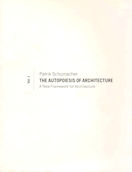By presenting architecture as a discipline with its own unique logic,
The Autopoiesis of Architecture provides a wholly new theoretical approach to architecture.
The impact of this is far reaching.
Architecture’s conception of itself is addressed
but also that of its development within wider contemporary society.
Schumacher’s innovative treatment of the subject enriches architectural theory
with a coordinated arsenal of concepts that facilitates
both detailed analysis and insightful comparisons with other domains,
such as art, science and politics.
The ‘Autopoiesis’ of the title refers to self-production:
the term having first been introduced in biology to describe
the essential characteristic of life as a circular organization
that reproduces all its specific components out of its own life process.
Once transposed into the theory of social systems,
autopoiesis came to be understood as a system of communication
capable of producing all its specific communication structures
within their own internal process.
It is this autopoietic system of communication that is being applied here
to an architectural context.
Architecture comprises various modes of communication,
including drawings, texts and built works.
These communications depend upon each other and combine
to reproduce architecture as a specialized system of communication.
The book explores how this system of communication forms a unique subsystem of society
that co-evolves with other important autopoietic subsystems like
art, science, politics and the economy.
The first of two volumes that together present a comprehensive account
of architecture’s autopoiesis, The Autopoiesis of Architecture:
A New Framework for Architecture introduces the theoretical framework
and traces the historical process of architecture’s differentiation
within its societal environment: its elevation above the craft of building,
its emancipation from religion and politics, as well as its separation from art and science.
On this basis Schumacher insists on the necessity of maintaining disciplinary autonomy
and argues for its distinct demarcation in relation to art and engineering.
Architecture’s dependency on theory is emphasized
and its internal separation into the avant-garde and the mainstream is explained.
Styles are theorized as design research programmes that constitute architectural history
as a progression of cycles of innovation that upgrade architecture
to adapt to the ongoing evolution of society.
This initial volume ends with the clarification of architecture’s
underlying societal function and raison d’étre.
The second volume completes the analysis of the discourse
and further proposes a new agenda for contemporary architecture
in response to the challenges and opportunities that confront
architectural design within the context of current societal and technological developments.
